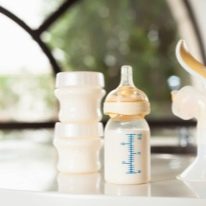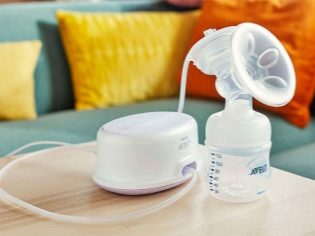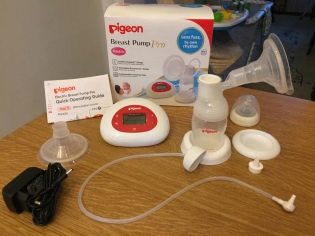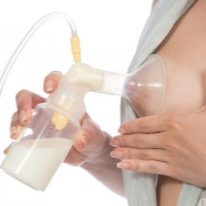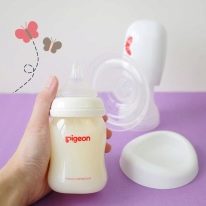How to use a breast pump?
When a woman’s breast milk is produced as much as her baby needs, there is no need for either expressing or buying a breast pump. But in practice this is not usually the case. The need for decanting may occur in the newly-made mother at any moment, and here not only the device itself is useful, but also a clear knowledge of how to use it correctly.
What is needed?
Breast pump is fully consistent with its name and is designed for sucking off breast milk, which the baby did not need for some reason. The reasons for expressing a woman may be enough. After delivery, when true breast milk has not yet “arrived,” it is recommended to express the colostrum. Not all do it manually, some begin to use the breast pump from the very first days after birth. How justified this is is another question.
In the process of breastfeeding, mothers can also wait for unpleasant surprises, for example, swelling of the mammary glands, if milk is produced significantly more than the baby consumes. In this case, there is pain in the area of the mammary glands, they swell, touching the chest causes great pain.
To avoid duct inflammation, stagnation in them, as well as the addition of infection, a woman will have to express excess milk. Here the correctly chosen breast pump will be most welcome. Sometimes mothers need to leave the baby for several hours or days - go on business, go to the hospital, go to relatives. In order not to transfer the child to artificial milk formulas, which are clearly inferior to breast milk in terms of benefit and composition, it makes sense to decant the breast milk, pasteurize it and leave it in the fridge for the time it is gone.
Sometimes the separation of the mother with the baby is more prolonged and forced in nature - the child is weak, is in intensive care, or the mother is in the hospital because of problems with her own health. In order not to lose lactation, while being treated or while the child is being treated, a mother needs to decant the incoming milk several times a day and dispose of it. Only then will milk production be continuous and stable. There is no way to do without a breast pump.
It is best to choose a breast pump before birth. A big mistake to send for the purchase of her husband when the woman is in the maternity hospital. The husband is unlikely to delve into the features of different models of this device. Most likely, he will buy either the most expensive one, or the one that comes first to his eyes. Not the fact that it will be convenient to use it.
It is worth spending a little of your own time before delivery to choose the right breast pump.
Kinds
Breast pumps are divided into two large groups - manual and electric. The first will require physical force, the second greatly facilitate the process of pumping. Both those and others have their advantages and disadvantages. The principle of operation for all, without exception, breastpumps, even self-made ones, is the same - they work according to the type of pump, create a vacuum in the area around the nipple, under internal pressure, the milk begins to flow into a special container that acts as a fluid receiver. When the pumping is completed, the milk from the tank is poured or disposed of.
Hand held
Manual breast pumps come in several forms.
- Pump vacuum device very simple - it is, in fact, a pear or pump and pad on the chest. The device also works very simply - you need to press on the pear and build up pressure around the nipple. Breast pump with a rubber bulb is the most economical and simple option. Pump suction is a bit more expensive, but it comes bundled with a special bottle that plays the role of a milk receiver during pumping.
- Syringe Hand Tools got this name for the principle of operation, which is very similar to the principle of the syringe. Suction is a two cylinder. The first is superimposed on the mammary gland, the second is set in motion by hand. At the expense of the piston creates a vacuum necessary for the process of the discharge of milk.
- Piston Breast Pump - This is the most expensive option among manual ones. It looks like a siphon. A special lining on the mammary gland is connected to a bottle for expressed milk, decanting takes place by pressing the small lever. It does not require much effort.
The advantages of hand-held devices are low price and ease of washing. To break such a device is very difficult, because it is simple and straightforward. The downside is that their productivity is low, and in the time it takes to get some milk, the hand will get very tired of the same type of mechanical movements.
Electric
Electrical devices relieve a woman of exhausting work by pumping and pumping up her hands to a state that any bodybuilder would envy, while they free her hands. While the milk is being drained, a woman can do something else. There is automatic vacuum suction on batteries, some models - from the outlet. The very principle of operation is the same, but with some nuances. In modern models, it is possible to turn on the pulse mode, which will simulate as much as possible the sucking of the infant, that is, the pressure will change in a pulsed manner. This is considered the most natural for the breast and has a positive effect on subsequent lactation.
The woman herself can change the pressure arbitrarily - if the milk flows easily, the nipples are “weak,” you can set a slight pressure. If the nipples are “strong” and are difficult to decant, the pressure at any minute can be increased to achieve the desired goal. Finally, electric models can give a young mother the most valuable thing - this is some free time for herself. This helps model suction with two simultaneous overlays. This means that it will be possible to simultaneously express both mammary glands at the same time at the same rate.
Anyone who believes that the above advantages eliminate disadvantages is deeply mistaken. Among the minuses in the first place you need to call the cost - it is quite high. The more functions are provided for, the more expensive the purchase will be. During operation, electrical devices are noisy, and this is not going anywhere. And also the woman will not be able to carry out a complete sterilization of the breast pump, since there are electrical blocks and circuits in it that will not tolerate any thermal, steam or any other treatment. This increases the likelihood of infection of the expressed milk with harmful bacteria, and the young mother can infect them with cracks in her nipples, if any.
Terms of use
Whichever device is chosen, it is necessary to strictly observe the following rules for its use, that will allow to maintain the breast in a healthy state, avoid stagnation of breast milk, and also allow to keep the breast pump in working condition:
- A new device must be removed from the box and thoroughly rinsed with warm water all parts that will be in direct contact with the mammary gland, as well as the milk receiver, if you plan to feed the expressed milk of the baby;
- the container for collecting milk should not forget to wash after each use, as well as to sterilize it;
- express milk only with clean hands;
- It is necessary to use the device only after a careful study of the instructions attached to it;
- In order to express breastmilk most comfortably and correctly, you should try to choose the optimal individual mode, if an electric breast pump is used, you should train it manually to work out the best pressure and intensity of movement;
- how often a breast pump can be used depends on personal needs, manufacturers do not regulate this, as well as the duration of a pumping session over time;
- after the pumping, it is necessary to wash the parts, sterilize those that need to be sterilized;
- Store the device in a special package or in a clean cool place; it is better to cover it with a clean, ironed cloth with a cloth to prevent dust from settling when it is used infrequently.
Some expensive electric models can be rented to try in action to make a final purchase decision. All electric models have a one-year warranty.
How to express milk?
Decanting requires a certain skill and skill. A woman who gave birth for the first time and never before faced with the need to stretch her breasts, may face a huge amount of difficulties and incomprehensible moments. Therefore, a manual model of breast milk suction is recommended to start pumping. It is more suitable for the inexperienced, as it gives the opportunity to examine their own breasts, to determine with what force the pressure of milk will come out freely.
Then, when lactation stabilizes, you can begin to apply electric. Regardless of the type of instrument or device used, the order of use will include several steps.
Training
Preparation before decanting involves several steps.
- At the preparation stage, a woman needs to immerse in the boiling water those parts of the breast pump that manufacturers recommend for sterilization. At this time, wash your hands thoroughly with baby soap, prepare a place for decanting.
- Breast rinsed with warm or cool water, but to use soap for washing the nipples is not recommended, because the alkaline environment dries the delicate skin of the breast. Overdried nipple tissue is more susceptible to the formation of painful cracks.
- Some doctors recommend taking a warm shower and drinking a glass of tea with milk before the start of pumping, which will provoke an influx of milk and ease the task.
Main process
The process of decanting is as follows:
- one of the mammary glands is fixed with the right hand, then the part of the device adjacent to it is fixed around the nipple so that the nipple itself is strictly in the center;
- after making sure that the pad fits tightly enough, you need to start pumping out by turning on the device or acting on the working part mechanically (depending on the type); at first, the milk will protrude in small drops, then it will begin to flow in a stream;
- in the process you need to stop and slightly massage the mammary gland with your hands in the direction from the base to the nipple along the ducts; press on the chest, squeeze it hard, do not need it - it is painful and traumatic, and most importantly, completely useless, after a light massage the process of squeezing resumes;
- the procedure should be continued until a feeling of emptiness and lightness in the breast appears;
- finished with one breast, you need to wipe it with a clean cloth and move the pad on the second breast; with her everything is repeated in the same way.
At the end of the pumping, rinse the nipples with cool water without soap, blot with a clean cloth or diaper. In the presence of cracks and damage, it is necessary to lubricate them "Bepantenom". The breast pump should be disassembled, washed, dried on a napkin without wiping.
It is possible to sterilize its separate parts immediately, or before the next decanting.
Tips
Do not worry if nothing happens right away. Experienced mothers know that sometimes they have to suffer a good deal of days with a breast pump in order to enjoy fast and high-quality pumping, which cannot be compared with manual pumping without the use of devices. All complaints like “it hurts”, “gaining a little” will gradually remain in the past, if you follow some of the “little tricks” that women have mastered with their own hard experience.
- It is necessary to turn pumping into a ritual, where everything is repeated up to trifles. It is necessary to drink the same drinks, to carry out the procedure in one place, at about the same time, and then the body itself will quickly “tune in” to the upcoming pumping and the milk will arrive as planned.
- A woman needs to learn to get rid of all the problems at least for the time of pumping. It is not necessary at this point to sort out the relationship with the household, watch the series or participate in the family council on the choice of new furniture in the bedroom. Doctors recommend a woman to relax internally, to imagine the sea, the beach, the ocean, a waterfall, in extreme cases, a clear and sonorous forest stream. Such associations contribute to easier passage of breast milk.
If everything is not the best with associative thinking, you should put a photo of the baby in front of you and look at it, which also contributes to lactation.
- To reduce stress during pumping, psychologists recommend a woman to include your favorite music or the sounds of the forest, nature, and the surf. No matter how difficult it is, you need to tune yourself from the very first days to the fact that the process of sucking milk is normal, not painful. Very soon he will really become like this.
- It is worth expressing milk as often as the child eats, that is, after each feeding. The baby is unlikely to suck the whole breast, and there is no need to leave milk in the ducts. Even a fully emptied breast in 2.5–3 hours, which will pass before the next feeding, will have time to completely restore the nutrient fluid reserves.
- Happy owners of the latest generation of electric suction can save their own time and carry out the pumping of one gland at the moment when the baby sucks the second.
- If it is not possible to set up the decanting with a breast pump throughout the week, despite the correct execution of the instructions and following all the tips, you should try to change the device to another one. This usually helps to solve the problem.
You will learn more about how to use a breast pump in the following video.



